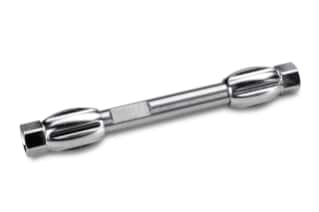
|
Chemistry |
Amide |
|
Separation Mode |
Hydrophilic Interaction (HILIC) |
|
Particle Substrate |
Hybrid |
|
pH Range Min |
2 pH |
|
pH Range Max |
11 pH |
|
Maximum Pressure |
6000 psi (415 Bar) |
|
Endcapped |
No |
|
Silanol Activity |
Low |
|
Molecular Weight Range Min |
1000 |
|
Molecular Weight Range Max |
150000 |
|
Particle Shape |
Spherical |
|
Particle Size |
3.5 µm |
|
Endfitting Type |
Waters |
|
Pore Size |
130 Å |
|
QC Tested |
Glycan |
|
Format |
Column |
|
Surface Area |
185 |
|
System |
HPLC |
|
Particle Technology |
BEH |
|
USP Classification |
L68 |
|
Inner Diameter |
2.1 mm |
|
Length |
50 mm |
|
Carbon Load |
12 % |
|
UNSPSC |
41115709 |
|
Application |
Glycan |
|
Brand |
XBridge |
|
Product Type |
Columns |
|
Units per Package |
1 pk |

XBridge Glycan BEH Amide Column, 130Å, 3.5 µm, 2.1 mm X 50 mm, 1K - 150K, 1/pk
Three highly scalable particle sizes for Waters BEH-based Glycan chemistry are offered to meet the needs of UPLC (1.7 µm) and HPLC-based (2.5 µm XP and 3.5 µm) application requirements. To ensure batch to batch uniformity and extremely identical separated glycan profiles, each batch of BEH Glycan material is precisely quality-controlled using the 2-AB labeled Waters Glycan Performance standard. Chromatographers can now select the most suitable LC-based technology to fit their unique released glycan analysis application needs and laboratory instrumentation, helping to ensure extremely similar results.
If you choose our tools, programs, chemistries, and services, you have all the tools you need to complete any analysis successfully. The best compatibility with your Waters instruments is achieved by using only Waters Quality Components, which have undergone extensive testing to guarantee that your Waters systems continue to operate at their maximum efficiency. You can rely on consistent instrument performance, precise and reproducible results, and maintained system compliance when you utilize Waters Quality Components.
On our website or in our brochure, you may evaluate the entire Waters product line. The website allows you toshop for lab equipment right away and to ask any inquiries you may have.
You may also be interested in viewing XBridge BEH Amide VanGuard Cartridge, 130Å, 3.5 µm, 2.1 mm X 5 mm, 3/pk; By eliminating particle pollution from the mobile phase stream, XBridge BEH Amide VanGuard Cartridges are used to increase analytical column lifetime and performance. All 2.1 mm and 3.0 mm I.D. XBridge BEH Amide analytical columns with 3.5 µm sorbent particles are protected by this cartridge.
What Sets C8 and C18 Columns Apart in HPLC?
In reverse-phase chromatography, C8 and C18 straight-chain alkyl groups are used to alter the surface of silica in HPLC. Reverse-phase chromatography is a procedure that makes use of an aqueous, moderately polar mobile phase. The presence of octyl carbon chain (C8)-bonded silica in the stationary phase of the former, as opposed to octadecyl carbon chain (C18)-bonded silica in the latter, is the main difference between C8 and C18 columns used in HPLC. Additionally, the C8 columns are denser and less hydrophobic than the C18 columns, which are both denser and more hydrophobic. As a result, the C8 columns show a short retention period, whereas the C18 columns show a longer retention time. As a result, the C8 columns achieve a lower level of separation, whereas the C18 columns offer a higher level.